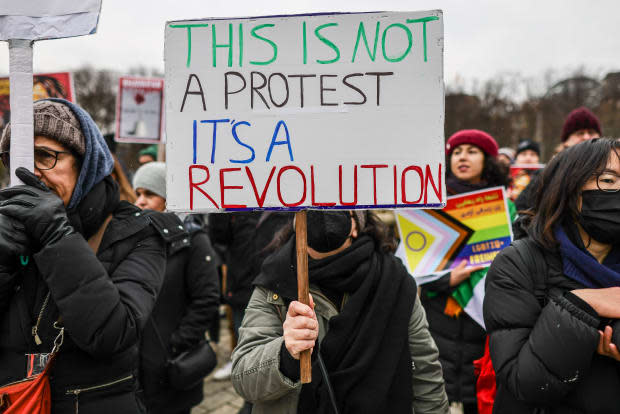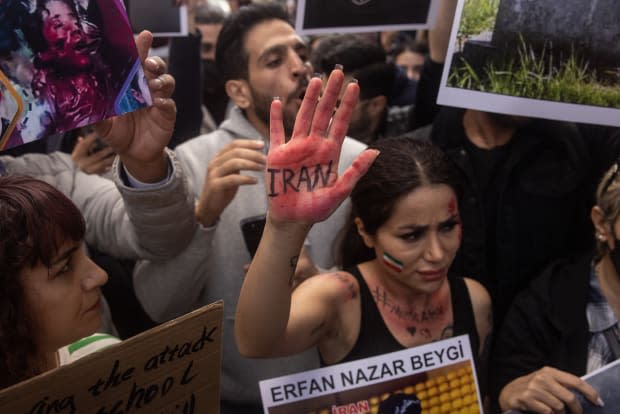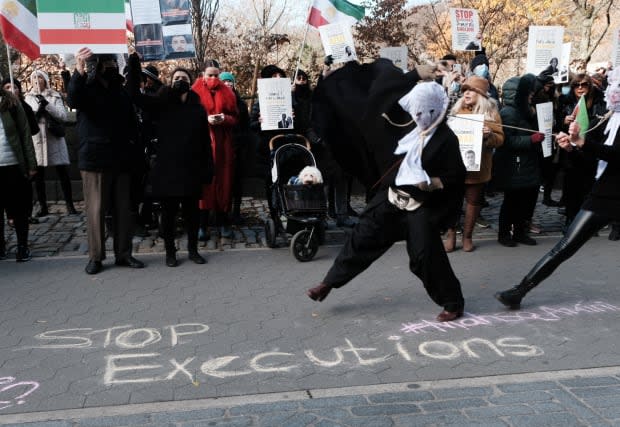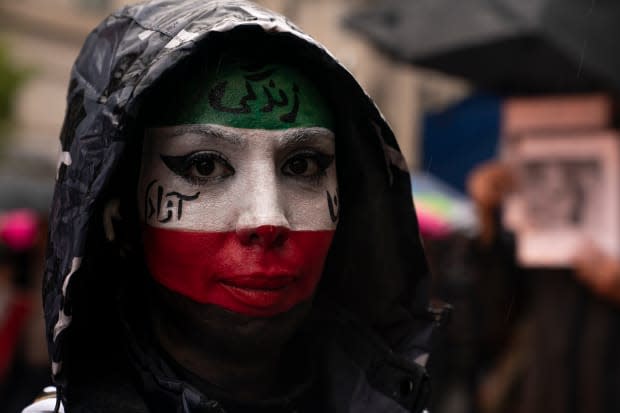Founded by Fashion and Beauty Professionals, the Iranian Diaspora Collective Wants You to Stop Forgetting About Iran
Jina Mahsa Amini's murder sparked protests last September that are still ongoing. A new U.S.-based group explains why they want to ensure they stay in the news.
When Jina Mahsa Amini died last September in custody after being arrest by Iran's morality police for not following the country's strict hijab laws, it ignited a movement.
Protestors around the world chanted: "Women, life, freedom." Those three words were plastered onto posters and T-shirts. (Even Meghan Markle wore one.) In Iran, demonstrations were often met with lethal force; it's estimated that thousands have died, and many more have been arrested.
Though Amini's killing sparked this, Nicolette Mason, a co-founder of the Iranian Diaspora Collective (IDC), explains that "Women, life, freedom" goes much deeper.
"The killing of Gina by the morality police was this powder-keg moment of unrest and opposition to the government, the Islamic Republic, that has been happening for decades," she says. "It ignited and reignited this resistance against the government to call for a revolution. I think the way a lot of people understand it is around this protest movement around hijab, and it's really not about that... It's about this overarching system of governance that's oppressive and that marginalizes diversity of any kind within the country."
After the 1979 Iranian Revolution (also known as the Islamic Revolution), there were very strict laws enacted, some of which forced women to wear hijabs and loose tunics over their clothing in public. Amini was detained for wearing her hijab loosely, technically improperly — though it has "almost become standard practice" to wear it this way, according to Time.
The feeling that this could have been anyone helped fuel the movement.
"The journalists who broke the news of Gina's killing were imprisoned. The country shut down access to internet," Mason explains. "There were all these suppression tactics to silence the people in Iran and a call for people outside of Iran to be the voice of those people."

Photo: Omer Messinger for Stringer/Getty Images
Watching the uprising from the outside made Mason and other members of the Iranian diaspora urgently want to amplify the voices of those on the ground. That's how the IDC — which is 501(c)(3)-pending — formed.
This group of U.S.-based creatives assembled to use their skills and networks to bring attention to what's been happening in Iran. Its five founding members include Mason, who works as a strategist and consultant in fashion and beauty, serial entrepreneur Moj Mahdara, filmmaker Roya Rastegar, marketing executive Mandy Ansari and fashion stylist Farnaz Dadashi. They're committed to advocacy for a liberated Iran and helping create "secular democracy" via storytelling.
"None of us individually had necessarily been involved in activism and advocacy specific to Iran," Mason says. "We've all in our professional lives — working in beauty, fashion, or [creative fields] — done our work through a social justice lens. But we're very new to Iran advocacy."
The collective's first project was an out-of-home campaign last November that drew attention to the situation in Iran and the voices of those protesting. It reached nearly 101 million accounts on Instagram.
View the original article to see embedded media.
The IDC also put together a living document that serves as a resource to help journalists and media covering Iran navigate cultural sensitivities.
"What's kind of paramount to us and who we are as individuals, as well as how we form this organization and how it mirrors people in Iran on the ground, is that we really do believe in the power of intersectional thought leadership and intersectionality as a framework for everything that we do," Mason says.
To that end, the IDC is non-partisan, queer-led and multifaith — which is in direct opposition to the norms of the regime. The Islamic Republic doesn't just target women, Mason explains: It also subordinates on the basis of race, sexual orientation, ethnicity and religion.
"There's extensive racial and ethnic marginalization that's institutionalized as part of the Islamic Republic's constitution, to the extent that ethnic minorities aren't allowed to teach their mother language. They're not allowed to give people names from their ethnic groups," she says. "The reason people know Jina as Mahsa Amini is because Jina is a Kurdish name, and legally, she had to have a Persian name, because people who aren't ethnically Persian and not Muslim have to have a name that's accepted by the Islamic Republic's National Register."
In Iran, more than 60% of the population is under 30. The increasingly youth-driven country and culture is growing restless in the face of the Republic.
"A lot of the people who are taking to the streets are really young, and they have grown up on TikTok and on Instagram," Rastegar says. "They're students. They have vlogs. They listen to Halsey and Selena Gomez. Like, they're literally the same as us. They dye their hair purple underneath the hijab that they have to wear when they go out. They have piercings. They're just cool and young, and they want to be free."

Photo: Chris McGrath/Getty Images
The filmmaker believes part of the recent uprising was a release of fear among this youngest generation: "Maybe they are afraid, but they're willing to sacrifice whatever they need to sacrifice for freedom. It's a mix of a couple things — I think it's past generations being held hostage, and looking at social media and the rest of the world being free... They're just like, 'We want this.'"
Recently, five Iranian girls made a viral TikTok with choreography to Rema's "Calm Down." But dancing in public is illegal in Iran — which is why it has become one of many forms of protest. "What followed was all of them were detained by the government and forced to make a public apology," Mason explains. "There are all these things that we take for granted as part of our everyday lives that are also enormous, like parts of expression, how we communicate culturally, how we connect with each other."
Rastegar points to the consequences of choice as a viewer: Sharing a video like that promotes visibility that might spread their message but egg on authorities to arrest and torture them.
"Our role as the audience is to also act as a distributor and to circulate and to talk about it and to watch them," she says. "They're asking us to witness them, and they're giving us their testimonies. It's not just the videos of people being shot and killed and beaten in the streets — there's lots of those — it's also the videos of five girls in a courtyard doing a TikTok dance."
"This attitude of 'it's so far away, it doesn't relate to me, it doesn't connect to me,' is something that we really think about a lot," Mason adds. "How do we make people understand that all of our oppressions are linked, and all of the systems of violence are linked to each other? That standing in solidarity and building coalitions with other groups of people empowers us all?"
For example, young artists have played a major role in resistance by using their medium to speak against the regime. Rastegar points to Iranian rappers Toomaj Salehi and Saman Yasin, who won an appeal against a death sentence last September. "They're people whose art form has been shaped by Black liberation cultures," she says. "Black women have been talking about this in the U.S. and in the Caribbean, in Latin America and South America for a long time. They have really articulated different ways of developing coalition, developing liberation strategies, creating alliances and figuring out how to articulate the connection of oppressions."

Photo: Spencer Platt/Getty Images
The IDC's campaign not only spread awareness of Amini's killing, but also showed how how the Republic targeting women underscores a broader aim to suppress self-expression. Rastegar believes the global media can put pressure on the government to change their behavior — at least in the short-run.
"We've seen, for example, that when people are on death row and the media circles around them, they get released. We've seen that kind of social media and media pressure work. The Iranian government is very sensitive to how it's represented in the world," she says.
Media tends to rely on governments for fact-checking and sourcing official information, but this becomes an issue when the government doesn't provide trustworthy information and may alter notices to fit its public image. In the case of Iran, that's meant foreign journalists taking the government's statements at face-value, even if it doesn't reflect the reality on the ground. (Example: the New York Times publishing an article titled "Iran Has Abolished Morality Police, an Official Suggests, After Months of Protests" last December, based on a general's off-hand comment during a meeting with officials.)

Photo: Nathan Howard for Stringer/Getty Images
"By relying on the government for official vetted information, when no outside independent sources are able to come in to vet or fact-check that information, they [Western media] inadvertently mimic propaganda points of the regime," Mason says. This is why it's important to work with citizen journalists and organizations like the Human Rights Activists News Agency, she explains.
Legislative pressure can be hoisted, too.
Introduced to Congress early January of 2023 and brought forth by U.S. Representative Jim Banks (IN-03), the MAHSA Act — which stands for the Mahsa Amini Human Rights and Security Accountability Act — would require President Joe Biden to reconsider sanctions and how Iran's President, Ebrahim Raisi, and Supreme Leader, Ali Khamenei, are designated under sanctions. Talking about and supporting this bipartisan policy initiative is important and has the power to "materially impact people on the ground in Iran," according to Mason.
Fashion and beauty professionals can further support Iran within their industries by supporting brands with Iranian founders or leaders, like Mike Amiri's Amiri, Sheena Yaitanes's Kosas Beauty and Brother Vellies, where Behnaz Ghahramani is CEO.
Right now, the IDC is planning its next project, centered around fundraising to bring internet access to more people in Iran, where the government controls the internet. This could help more information come out of Iran without needing to rely on the Republic's press team.
"Iranians are being held hostage by their own government — and it's been generations of Iranians," Rastegar says. The uprising reminds her of a line from Margaret Atwood's "The Handmaid's Tale": "They should have never given us uniforms if they didn't want us to be an army."
Correction: A previous version of this article misidentified Dr. Angela Davis as a founding member of IDC. Rastegar earned her PhD under the guidance of Dr. Davis, but she is not a member.
Want the latest fashion industry news first? Sign up for our daily newsletter.
